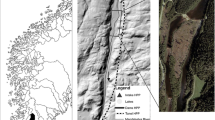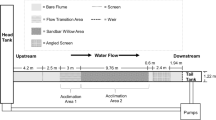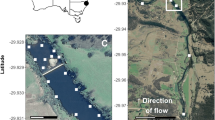Abstract
We assessed the effectiveness of pulse flows in facilitating the upstream migration of an imperiled summer-run Chinook salmon (Oncorhynchus tshawytscha) stock in the Puntledge River, BC, Canada. During July and August, over 3 years, we tracked radio-tagged fish (n = 100) in a reach of the Puntledge River where water is diverted for power generation, resulting in stable low flows that are believed to impede migration. Over the course of 13 pulse flows, we measured migration rate, passage rate at natural barriers that are difficult to pass during low flows, movement away from the turbine outlet pool that creates distracting flows, and locomotor activity. Mean river flow during the peak of the pulses varied from 12.1 to 42.5 m3 s−1 and was at least 6.1 m3 s−1 above residual base flows. Typically, the pulse flows lasted 48 h. Migration rate was higher during some pulse flows, but results varied among pulses. Passage at natural barriers was only higher during an abnormal pulse where flows reached twice that of the prescribed flow (i.e., 24+ m3 s−1). Some fish moved away from the turbine outlet pool during pulse flows. Pulse flows did not affect fish activity levels, as measured by electromyogram telemetry. Although the effect of pulsed flows on the migration of the Puntledge River summer-run Chinook salmon was unclear, no negative impacts, such as hyperactivity or downstream displacement were observed. The use of pulse flows as a management tool still requires further research.





Similar content being viewed by others
References
Banks JW (1969) A review of the literature on the upstream migration of adult salmonids. J Fish Biol 1:85–136
Baxter G (1961) River utilization and the preservation of migratory fish life. Proc Inst Civil Eng 18:225–244
Brown RS, Tatara CP, Stephenson JR, Berejikian BA (2007) Evaluation of a new coded electromyogram transmitter for studying swimming behaviour and energetics in fish. North Am J Fish Manag 27:765–772
Cocherell SA, Cocherell DE, Jones GJ, Miranda JB, Thompson LC, Cech JJ Jr, Klimley AP (2010a) Rainbow trout Oncorhynchus mykiss energetic responses to pulsed flows in the American River, California, assessed by electromyogram telemetry. Environ Biol Fishes 90:29–41. doi:10.1007/s10641-010-9714-x
Cocherell SA, Jones GJ, Miranda JB, Cocherell DE, Cech JJ Jr, Thompson LC, Klimley AP (2010b) Distribution and movement of domestic rainbow trout, Oncorhynchus mykiss, during pulsed flows in the South Fork American River, California. Environ Biol Fishes 89:105–116
Cooke SJ, Thorstad E, Hinch SG (2004) Activity and energetics of free-swimming fish: insights from electromyogram telemetry. Fish Fish 5:21–52
Cooke SJ, Hinch SG, Crossin GT, Patterson DA, English KK, Shrimpton JM, Van Der Kraak G, Farrell AP (2006) Physiology of individual late-run Fraser River sockeye salmon (Oncorhynchus nerka) sampled in the ocean correlates with fate during spawning migration. Can J Fish Aquat Sci 63:1469–1480
Crossin GT, Hinch SG, Cooke SJ, Welch DW, Lotto AG, Patterson DA, Jones SRM, Leggatt RA, Mathes MT, Shrimpton JM, Van Der Kraak G, Farrell AP (2008) Exposure to high temperature influences the behaviour, physiology, and survival of sockeye salmon during spawning migration. Can J Zool 86:127–140
Ecofish Research Ltd (2010) Assessment of adult fish passage at Dickson Falls during pulse flow releases from Elsie Lake Dam-year 5 summary report. BC Hydro, Canada
Gido KB, Larson RD, Ahlm LA (2000) Stream-channel position of adult rainbow trout downstream of Navajo Reservoir, New Mexico, following changes in reservoir release. North Am J Fish Manag 20:250–258
Gowans ARD, Armstrong JD, Priede IG, Mckelvey S (2003) Movements of Atlantic salmon migrating upstream through a fish-pass complex in Scotland. Ecol Freshw Fish 12:177–189
Hasler CT, Donaldson MR, Sunder RPB, Guimond E, Patterson DA, Mossop B, Hinch SG, Cooke SJ (2011) Osmoregulatory, metabolic and nutritional condition of summer-run male Chinook salmon in relation to their fate and migratory behavior in a regulated river. Endanger Species Res 14:79–89
Hasler CT, Cooke SJ, Hinch SG, Guimond E, Donaldson MR, Mossop B, Patterson DA (2012a) Thermal biology and bioenergetics of different upriver migration strategies in a stock of summer-run Chinook salmon. J Therm Biol 37:265–272
Hasler CT, Mossop B, Patterson DA, Hinch SG, Cooke SJ (2012b) Swimming activity of migrating Chinook salmon in a regulated river. Aquat Biol 17:47–56
Hinch SG, Rand PS (1998) Swim speeds and energy use of upriver-migrating sockeye salmon (Oncorhynchus nerka): role of local environment and fish characteristics. Can J Fish Aquat Sci 55:1821–1831
Huntsman AG (1948) Freshets and fish. Trans Am Fish Soc 75:257–266
Keefer ML, Peery CA, Bjornn TC, Jepson MA (2004) Hydrosystem, dam, and reservoir passage rates of adult Chinook salmon and steelhead in the Columbia and Snake Rivers. Trans Am Fish Soc 133:1413–1439
Komori Wong Environmental, Bixby B (2003) 2002 Puntledge River summer run Chinook radio telemetry study, Draft Report. Prepared for BC Hydro, Burnaby
Murchie KJ, Smokorowski KE (2004) Relative activity of brook trout and walleyes in response to flow in a regulated river. North Am J Fish Manag 24:1050–1057
Nehlsen W, Williams JE, Lichatowich JA (1991) Pacific salmon at the crossroads: stocks at risk from California, Oregon, Idaho, and Washington. Fisheries 16(2):4–21
Quinn TP (2005) The behavior and ecology of Pacific salmon and trout. American Fisheries Society, Bethesda
Ramstad KM, Woody CA (2003) Radio tag retention and tag-related mortality among sockeye salmon. North Am J Fish Manag 23:978–982
Sheer MB, Steel EA (2006) Lost watersheds: barriers, aquatic habitat connectivity, and salmon persistence in the Willamette and Lower Columbia River basins. Trans Am Fish Soc 135:1654–1669
Taylor JA, Guimond E (2004) Puntledge River summer run Chinook radio telemetry study 2003. BC Hydro, Canada
Taylor JA, Guimond E (2006) Puntledge River 2005 summer run Chinook radio telemetry study. Prepared for Fisheries and Oceans Canada, Nanaimo and BC Hydro, Burnaby
Taylor MK, Hasler CT, Findlay CS, Lewis B, Schmidt DC, Hinch SG, Cooke SJ (2013a) Hydrologic correlates of bull trout (Salvelinus confluentus) swimming activity in a hydropeaking river. River Res Appl. doi:10.1002/rra.2673
Taylor MK, Hasler CT, Hinch SG, Lewis B, Schmidt DC, Cooke SJ (2013b) Reach-scale movements of bull trout (Salvelinus confluentus) relative to hydropeaking operations in the Columbia River, Canada. Ecohydrology. doi:10.1002/eco.1429
Thorstad EB, Heggberget TG (1998) Migration of adult Atlantic salmon (Salmo salar); the effects of artificial freshets. Hydrobiologia 371(372):339–346
Thorstad EB, Økland F, Kroglund F, Jepsen N (2003) Upstream migration of Atlantic salmon at a power station on the River Nidelva, Southern Norway. Fish Manag Ecol 10:139–146
Thorstad EB, Fiske P, Aarestrup K, Hvidsten NA, Hårsaker K, Heggberget TG, Økland F (2005) Upstream migration of Atlantic salmon in three regulated rivers. In: Spedicato MT, Lembo G, Marmulla G (eds) Aquatic telemetry: advances and applications. Proceedings of the fifth conference on fish telemetry held in Europe. Ustica, 9–13 June 2003. FAO/COISPA, Rome, pp 111–121
Tiffan KF, Haskell CA, Kock TJ (2009) Quantifying the behavioural response of spawning chum salmon to elevated discharges from Bonneville Dam Columbia River, USA. River Res Appl 26:87–101
Young P, Cech JJ, Thompson LC (2011) Hydropower-related pulsed-flow impacts on stream fishes: a brief review, conceptual model, knowledge gaps, and research needs. Rev Fish Biol Fish 21:713–731
Acknowledgments
The authors would like to thank all of the field assistants (especially Rana Sunder, Samantha Wilson, Mark Taylor, Cody Dey, Mike Donaldson, and Charles Hatry), Puntledge Hatchery staff (DFO), John Taylor, and BC Hydro staff that provided support for this project. Funding was provided by BC Hydro. CTH was funded by an Alexander Graham Bell Canadian Graduate Scholarship and SJC is supported by the Canada Research Chairs program and NSERC.
Author information
Authors and Affiliations
Corresponding author
Rights and permissions
About this article
Cite this article
Hasler, C.T., Guimond, E., Mossop, B. et al. Effectiveness of pulse flows in a regulated river for inducing upstream movement of an imperiled stock of Chinook salmon. Aquat Sci 76, 231–241 (2014). https://doi.org/10.1007/s00027-013-0332-5
Received:
Accepted:
Published:
Issue Date:
DOI: https://doi.org/10.1007/s00027-013-0332-5




